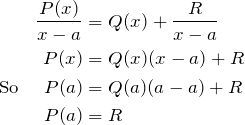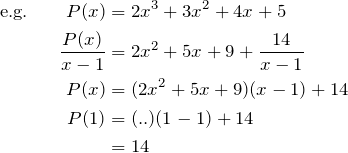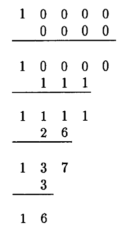It seems there is a great confusion of terms in this area.
What is commonly called synthetic division is just one type of synthetic division, division of a polynomial by ![]() , for which it seems the best name is Ruffini’s rule.
, for which it seems the best name is Ruffini’s rule.
Horner’s rule, or Horner’s form, is a polynomial in the form:
![]()
Horner’s method is a way of finding roots of a polynomial, by repeatedly reducing the equation by the integer part of a root, and multiplying the coefficients by factors of 10 to obtain further digits.
These are related but separate things.
E. J. Barbeau’s Polynomials – a problem book describes evaluating a polynomial by ‘constructing Horner’s table’ (i.e. plugging in e.g. ![]() to the Horner form) as ‘Horner’s method’. And then shows that this is an identical process to dividing the polynomial by
to the Horner form) as ‘Horner’s method’. And then shows that this is an identical process to dividing the polynomial by ![]() . I suppose the confusion comes from these 2 procedures being identical. Although neither is apparently Horner’s method. He does division by polynomials of a higher degree with “Horner’s Method of Synthetic Division which can be regarded as a generalization of his method for division by a binomial
. I suppose the confusion comes from these 2 procedures being identical. Although neither is apparently Horner’s method. He does division by polynomials of a higher degree with “Horner’s Method of Synthetic Division which can be regarded as a generalization of his method for division by a binomial ![]() “.
“.
++++(He also adapts Horner’s table to convert powers and polynomials to falling (factorial) powers and polynomials – see below.)
Dividing a polynomial ![]() by
by ![]() with Ruffini’s rule either results in a remainder of
with Ruffini’s rule either results in a remainder of ![]() , in which case
, in which case ![]() is a root, or a remainder
is a root, or a remainder ![]() .
.
The polynomial remainder theorem states:
If a polynomial ![]() is divided by
is divided by ![]() , then the remainder is a constant given by
, then the remainder is a constant given by ![]() .
.


Barbeau’s table used to convert ![]() to falling powers:
to falling powers:

references
Mathews, Walker – Mathematical Methods of Physics, 1971, p361-3